Deja Vu – A Plane Spotting Challenge by John Madden
Catch up on the previous reports from this challenge:
Introduction
Trip Report #1
Trip Report #2
Trip Report #3
Trip Report #4
Trip Report #5
*Trip Report #6
14-16 October 2021
Meet the Fokkers
Schiphol, Lelystad, Breda, Woensdrecht, Hoogerhilde, Eindhoven, Baarlo, Kevelaer, Cologne Butzweilerhof, Maastrict & Schiphol
by John Madden
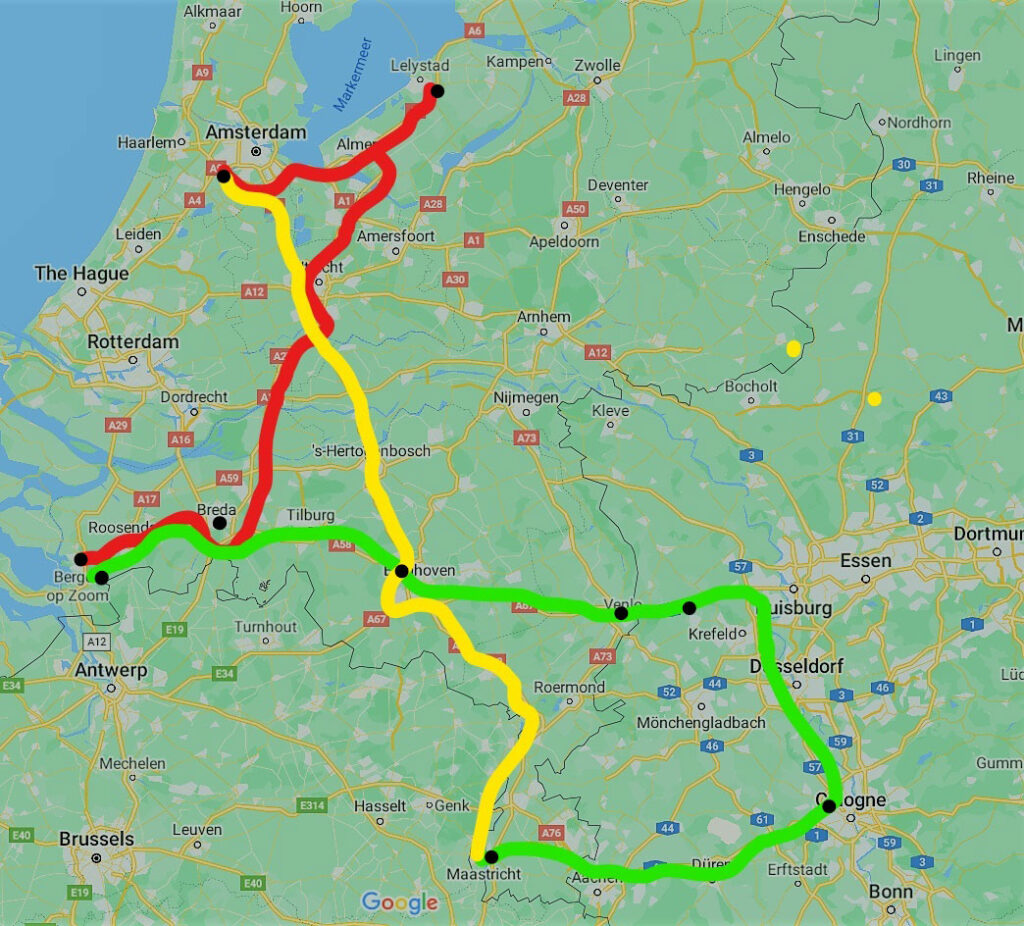
The spotting trip route. Red route: Thursday. Green route: Friday. Yellow route: Saturday. Black dots are spotting locations along the route.
Time for another spotting trip
A trip to the Netherlands to spot the Fokker family of regional airliners was always intended as part of this Challenge. With the clocks about to go back and the sun low in the sky it felt like the right time to squeeze in another spotting trip before the days become too short and misty for worthwhile spotting.
Founded by Anthony Fokker in 1912, Fokker went on to become a significant player in the 1920s civil aircraft market with types such as the 8-12 seat Fokker F.VII single engine passenger plane. The company lost its way somewhat during the 1930s as US manufacturers such as Douglas launched airliners built using aluminum in place of traditional aviation materials like wood and metal.
It wasn’t until the 1950s that the company re-entered the civil airliner market and it is this generation of regional airliners that sparked my interest as a teenager in Fokker. Both the F27 and F28 were common sightings across the British domestic route map during the 1960s-80s period, with British Midland, Air Anglia and Air UK examples plying their trade away from the busy London airports. The F27 family went on to be Fokker’s most successful post WW2 aircraft with Fokker and Fairchild USA building almost 800 examples between them. Following on from the success of the F27 and F28 airliners, Fokker embarked upon a major update of both models and developed the Fokker 50 and Fokker 70/100 respectively as replacement types.
I am confident that this trip will deliver the many different models of the F27 family along with a Fokker 50, Fokker 70, and Fokker 100. Despite a production run of 241 examples, not a single complete F28 airframe can be found in the Netherlands. The sole surviving example of this wonderful airliner in Europe is the Braathens S.A.F.E. F28-1000 LN-SUC on display at the Norwegian Aviation Museum in Bodo. Unfortunately, I cannot dove-tail Bodo into this 3-day road trip so spotting an F28 must wait until the days are longer and I can find an excuse to venture beyond the Artic circle. For me, not having an F28 on display in the Netherlands is akin to not finding a BAC 1-11 in the UK.
Ironically my first flight on any Fokker airliner was in 1987 aboard an F28, an Air France 3000 variant from Heathrow to Lyon and I remember the occasion very well. It was a typical busy early Heathrow morning and, as we crawled along behind much larger aircraft, suddenly we left the queue, joined 27L part way down the runway, applied the brakes and dutifully wound up the pair of eager Spey engines ahead take-off clearance. Brakes off, and with that sudden thump between the shoulders associated with rear engine jet aircraft, we sped off down the runway and rotated in no time at all to screech impressively skywards over Hatton Cross. I was seated close enough to see through the open flight deck door (those were the days), and could sense that the flight crew enjoyed every moment too, a text book F28 departure. Back to the present and my trip to the Netherlands.
Thursday 14th October: BA430 LHR to AMS
You know the drill; twenty-minute drive to Heathrow, Purple Parking, kerosene fix, transfer bus to T5, British Airways A320 at my gate. I thought I knew the drill too! Having expected to fly on a routine A319/A320 rotation to Amsterdam, British Airways had up scaled the flight to a Boeing 787-8. A pleasant surprise and a good start to this spotting trip as I had not previously flown on this variant of the Dreamliner. The flight time to Amsterdam was a rather quick 41 minutes and I am confident this could well forever remain my shortest flight on a Dreamliner. Though not as short as the flight time recorded by the Manchester United first team last month on their infamous Avro RJ85 flight from Manchester to East Midlands to play Leicester City.
Fast forward to Schiphol and it is 34 years since I first landed at this impressive airport and it’s not too long before my head is full of fond memories. Having been invited all those years ago to my cousin’s wedding in Canada, I began checking out the various airline schedules between Heathrow and Toronto and plumped for the in-direct flight with Air Canada via Montreal on a Lockheed L1011-500, an aircraft type missing from my “flown-on-list”. One notable recollection on both westbound legs was that the aircraft sat nose up in the cruise, attributable I assume to the fact that the shortened fuselage affected the aircraft flight dynamics compared to its larger sibling? I remember the push service trolleys having a mind of their own during meal times and the crew continuously had to be alert as not to allow them to roll starboard when unattended. Apart from that amusing little nuance the L1011-500 certainly felt a very accomplished aircraft indeed and the short sector between Montreal and Toronto was a real breeze.
So how did Schiphol enter the travel equation you ask? This was the 1980s and during the last week of my visit a strike by Air Canada employees brought the airline to its knees just when I was due to return home. In a world without internet, laptop or smartphone, my travel agent and I managed to secure an alternative flight to Heathrow but via Amsterdam with KLM. For most people this would have been a real inconvenience, but for me, it simply offered up an additional spotting experience.
The Air Canada strike really did come up trumps. My return flight to Heathrow via Amsterdam not only presented a new airport, but also two new aircraft types to add to my “flown on list”. The Toronto to Schiphol schedule was aboard a Boeing 747-200 (SUD) Combi and the connecting flight to Heathrow on a Boeing 737-300, the latter type being a relative newcomer to European skies and real treat to fly on. On the transatlantic leg to Schiphol the cabin crew not only allowed me on the flight deck, but also showed me the large cargo area at the rear of the aircraft. I am very much looking forward to being reunited with a KLM Boeing 747 200 SUD again as my first stop on this trip is home to Boeing 747-200 (SUD) PH-BUK.
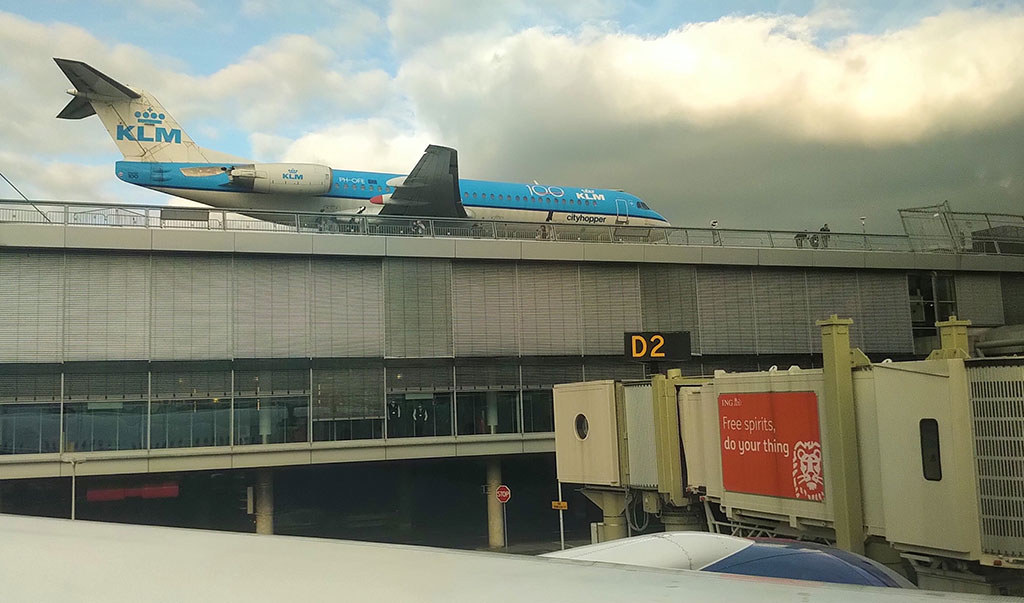
F100 PH-OFE from row 24 on BA B787
On arrival at Schiphol, I could not have been more surprised than when our Dreamliner pulled up at gate D2, directly below Fokker 100 PH-OFE standing proudly on the Panorama Terrace above Departure Hall 1. I didn’t expect to see this aircraft, well not in its full glory, until I returned to Schiphol on Saturday afternoon. First member of the Fokker family suitably noted and photographed. This aircraft was delivered new to Inter Canadien Airlines in 1989, flew with Air UK for a short while before returning to the Netherlands in 2003 for service with KLM Cityhopper until retired in 2010. My first flight on a Fokker 100 was in 1995 from Paris Orly to London Heathrow aboard a TAT European Airlines liveried aircraft owned by British Airways.
Lelystad Aviodrome
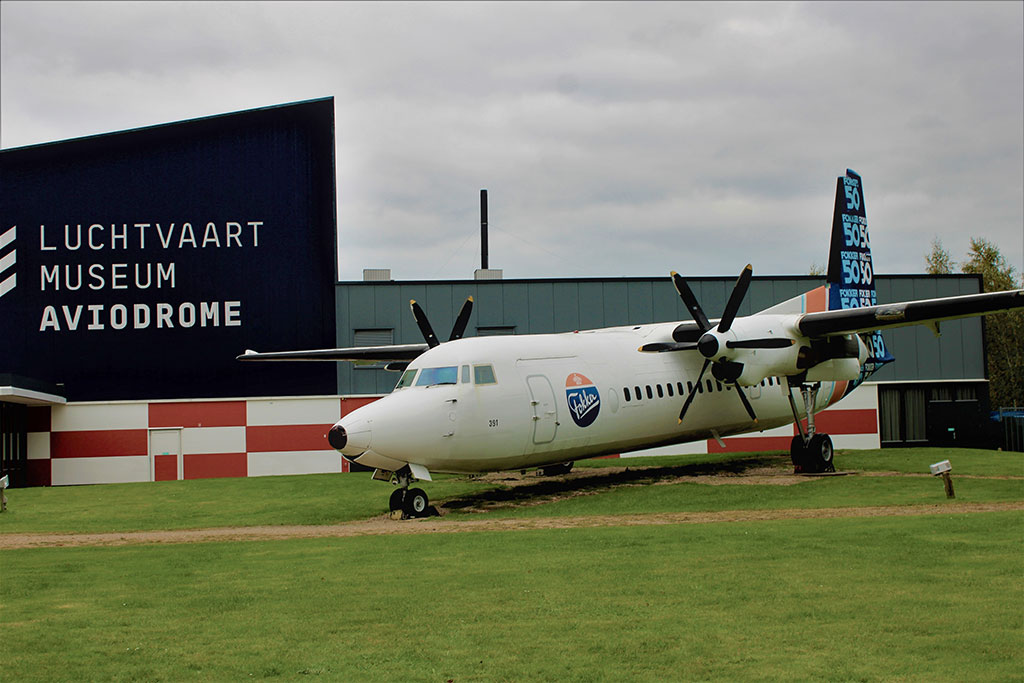
F50 PH-OSI at Aviodrome entrance
We are all aware of the modest but impressive collection of airliners located at this renowned aviation museum, but what I didn’t appreciate was just how good an exhibition I was about to walk in to. I had budgeted just 30 minutes on site, but having entered the Aviodrome it soon became obvious that this was woefully inadequate. Starting with WW1 and the Red Baron, the exhibition trail takes one through the 1920s/30s straight into occupied Netherlands complete with German paratroopers jumping from a JU52. The post WW2 era presented a Douglas DC3 and Lockheed Constellation, both in KLM livery, after which I walked straight in to the 1960s with F27 prototype PH-FHF along with Martins Air Charter De Havilland Devon PH-MAD. I was truly encapsulated by this aeronautical stroll through time, and it threw my allocated “visit time” right out of the window.
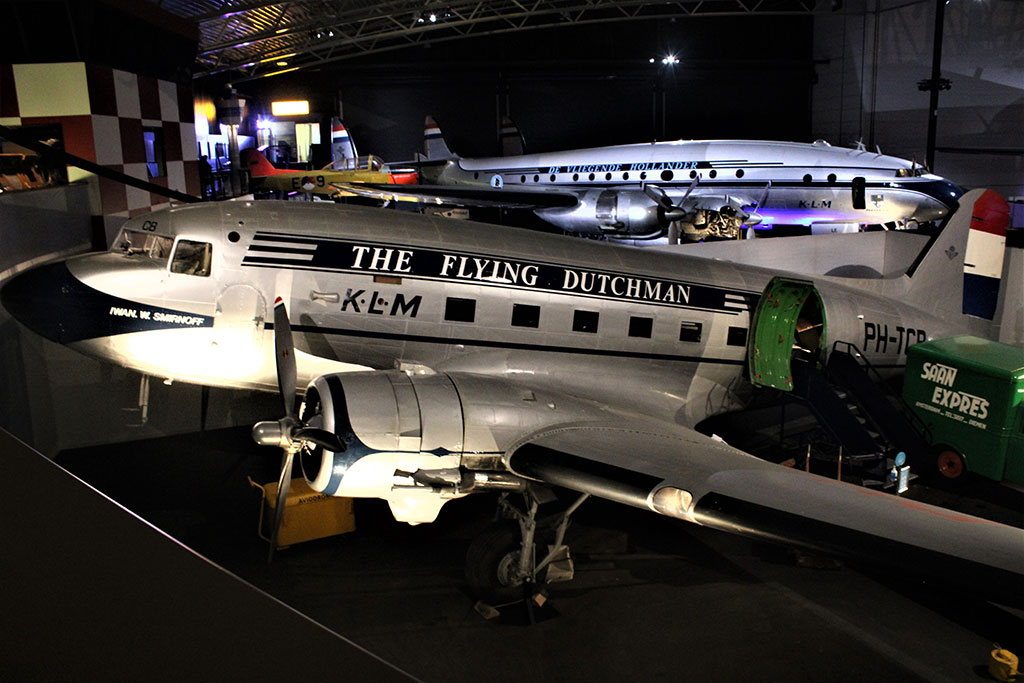
Finally, and pure genius it is too, one can walk from the indoor exhibition via an air bridge straight onto Boeing 747 200 (SUD) PH-BUK; the air bridge windows providing an appetizing view of the aircraft on display outdoors. Thinking I would transit the aircraft swiftly, I unashamedly consumed plenty more time whilst mulling around this truly magnificent exhibit. I never thought I would step on board a Boeing 747 ever again, never mind a passenger version. No prizes for guessing on which airliner the below photograph was taken, for me this passenger compartment epitomizes the Boeing 747.
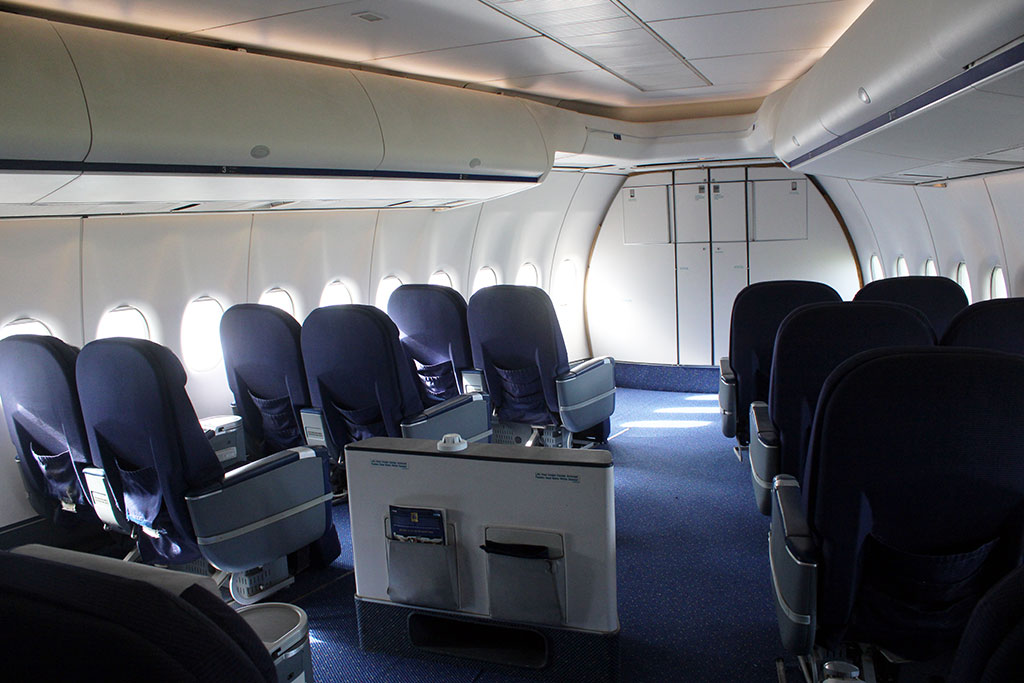
KLM 747 SUD 1st class cabin
Departing the Boeing 747 via conventional air stairs on the starboard side of the aircraft, one is quite literally brought down to earth and I can once again get on with the job I came to the Netherlands to do. Second Fokker 100 of the day is PH-OFA, parked in an open and uncluttered area resplendent in KLM Cityhopper livery.
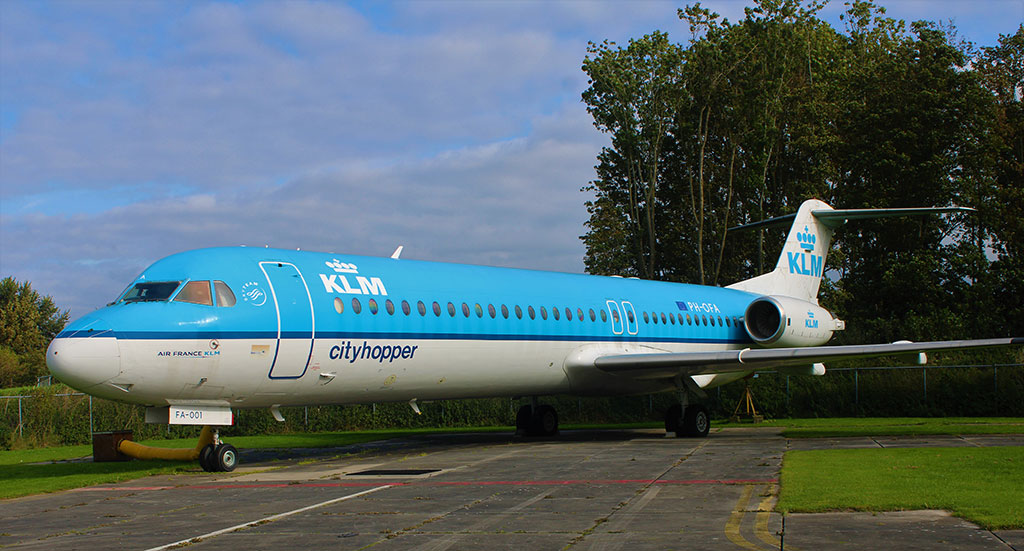
KLM Fokker 100 PH-OFA
Standing nostalgically in front of the former airfield terminal building complete with Anthony Fokker titles below the flight deck windows is NLM F27-100 PH-NVF, the first production F27-100. This aircraft was delivered to launch customer Aer Lingus in 1958 as EI-AKA and this type has a very special place in my aviation past. My Canadian auntie and uncle visited Liverpool in 1964 and my father took me to Speke airport to meet them on the last sector of their journey from Toronto. The journey had included a Trans Canada Airlines Vickers Vanguard to New York, Aer Lingus Boeing 707 to Dublin and finally an Aer Lingus F27 to Liverpool. That Aer Lingus F27 was the first aircraft I ever saw on the ground and I now have the entire family on both sides of the Atlantic searching through photo albums and cine reels to find it so that I can establish whether or not it was indeed EI-AKA. The aircraft moved down under in 1966 and went on to serve in Australia and New Zealand right up to 2004 when it returned to the Netherlands for permanent display.
Having quickly taken photographs of the two outdoor Fokker airliners and resident KLM Douglas DC-4 PH-DDY, I popped into the Hanger 2 to spot DC-2 N31965, Martins Air Charter DC3 PH-DDZ and various other classic aircraft under restoration including a Noord Nuysman. There was also the rear fuselage of an F27 in storage.
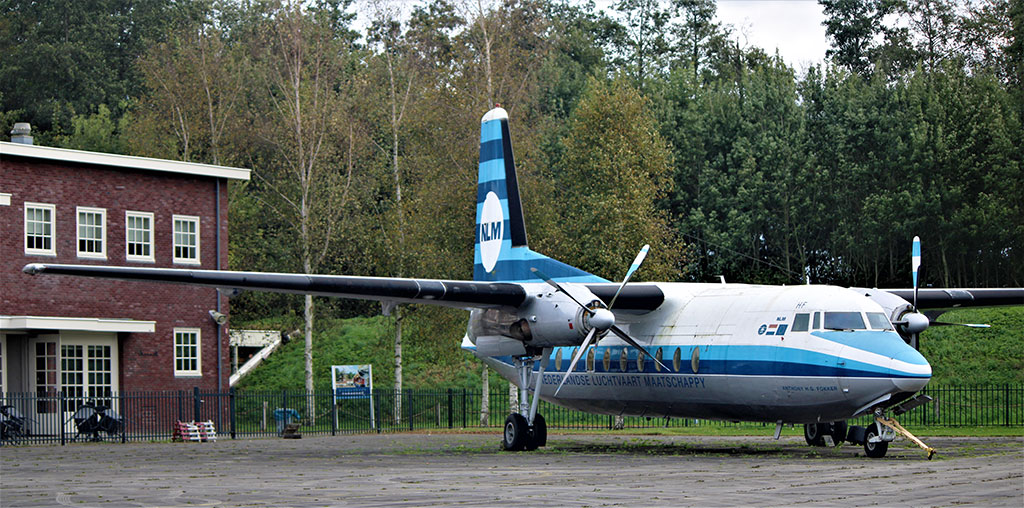
NLM F27 PH-NVF
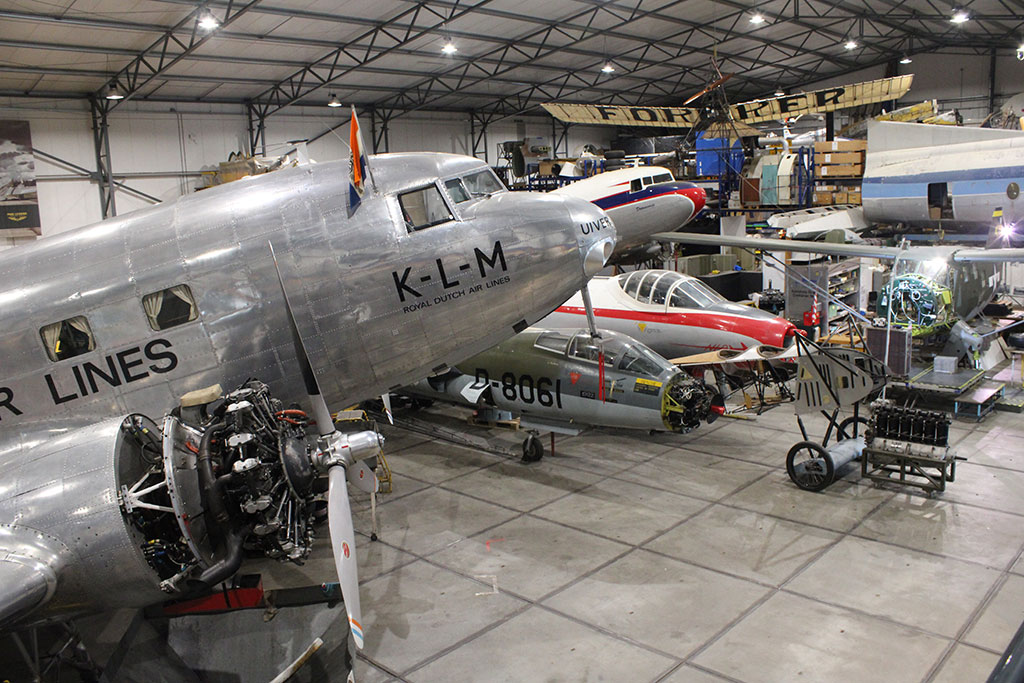
Conscious that I was running behind schedule, I reluctantly back tracked to the car but not without having a few reminiscent minutes with Fokker 50 prototype PH-OSI. My first flight on a Fokker 50 was back in 1989 on an Aer Lingus service from Dublin to East Midlands airport. My next spotting destination is Breda, a 90-minute drive south.
Breda: Stolwerk Metaal Co, Valveeken 5-14, 4815 HL
If ever there was an obvious paradox in the world of aviation, then I found it in the city of Breda. Perched aloft a 3-story building in the middle of an industrial zone is Fokker 100 c/n 11508 (test registration PH-EZH). Now owned by Stolwerk Metaal, this aircraft has the accolade of being the last Fokker regional airliner ever built and is now used as an employee rest area. Destined for TAM this aircraft fell victim to the financial woes associated with the impending collapse of Fokker in 1996 and was never delivered to the airline.
Let us sincerely hope that the owners of Stolwerk Metaal never feel the urge or need to put this invaluable aviation asset through their shredder. I have witnessed some unusual employee break time facilities on my work travels during the last 40 years, but this certainly ranks as one of the most imaginative and certainly impressive. This photograph may well go down as one of the quickest aircraft spotting moments of this Challenge. Having driven for 90 minutes and still a little behind schedule, I parked up, took a few steps back, photographed the aircraft, got back in the car and set off for my next destination, Woensdrecht.
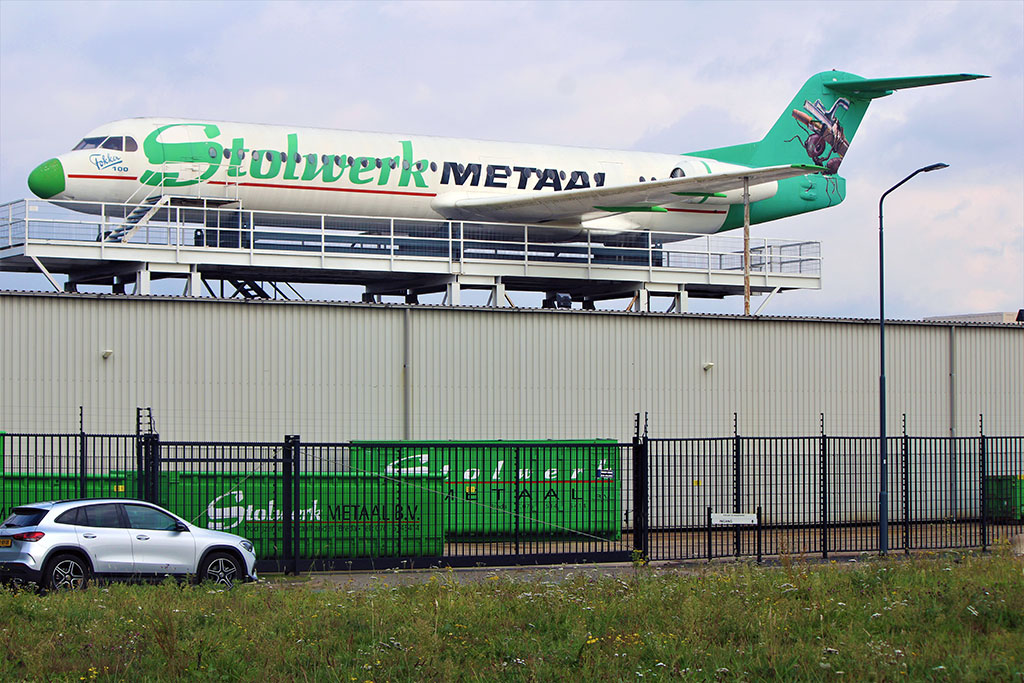
Stolwerk F100
Bergen op Zoom Woensdrecht Airbase
This airbase/airport has a long association with Fokker and was used right up to 1996 as a secondary production line and maintenance facility. The prototype Fokker 70 maid its maiden flight from this airport in 1994 and the site has now become home to Fokker Services who provide global support for surviving Fokker aircraft. My pre-trip research showed that a pair of Fokker 70s belonging to the former Cypriot airline TUS Air were on site and offered my only chance of spotting a complete Fokker 70 airframe on this trip. Thankfully both aircraft where still in situ along with former sister ship Fokker 100 5B-DDE, but all three proved difficult to photograph being parked behind a long wall. To give you a glimpse of one of these aircraft in service I have included a short video of Fokker F70 5B-DDF landing at Skiathos airport only a couple of summers ago.
Both Fokker 70s were delivered new to Silk Air in 1995 and returned to Europe in 2000 to join KLM Cityhopper with whom they served until moving on to TUS Air in 2017/18. The Fokker 100 was delivered new to American Airlines in 1992 and later spent 12 years in Brazil before entering service with TUS Air in 2018.
My first flight on a Fokker 70 was from Heathrow to Rotterdam in 1998, not surprisingly on a KLM Cityhopper. My last flight on a Fokker 70 and incidentally my final flight on any type of Fokker aircraft was on March 10th 2004, a British Midland service from Manchester to Heathrow. Prince Willem Alexander of the Netherlands frequently flew as a co-pilot on KLM Cityhopper before later becoming King. I would like to think that perhaps he flew one of my Fokker 70 flights during the 10 years I travelled back and forth on a monthly basis between Heathrow and Rotterdam. We will never know as apparently the Prince refrained from giving his name when making a pre flight or landing announcement in order to maintain his anonymity. The Fokker 70 was the very last Fokker aircraft operated by KLM, and after a 97-year relationship with Fokker, the airline flew its 4 remaining Fokker 70s into retirement on 29th October 2017.
What I didn’t expect to find at Woensdrecht however, was a rather exciting “in-between owners” collection of Airbus A330-200 aircraft along with a mixed bag of largely white-tailed narrow body airliners including a pair of Guernsey registered Airbus A319s.
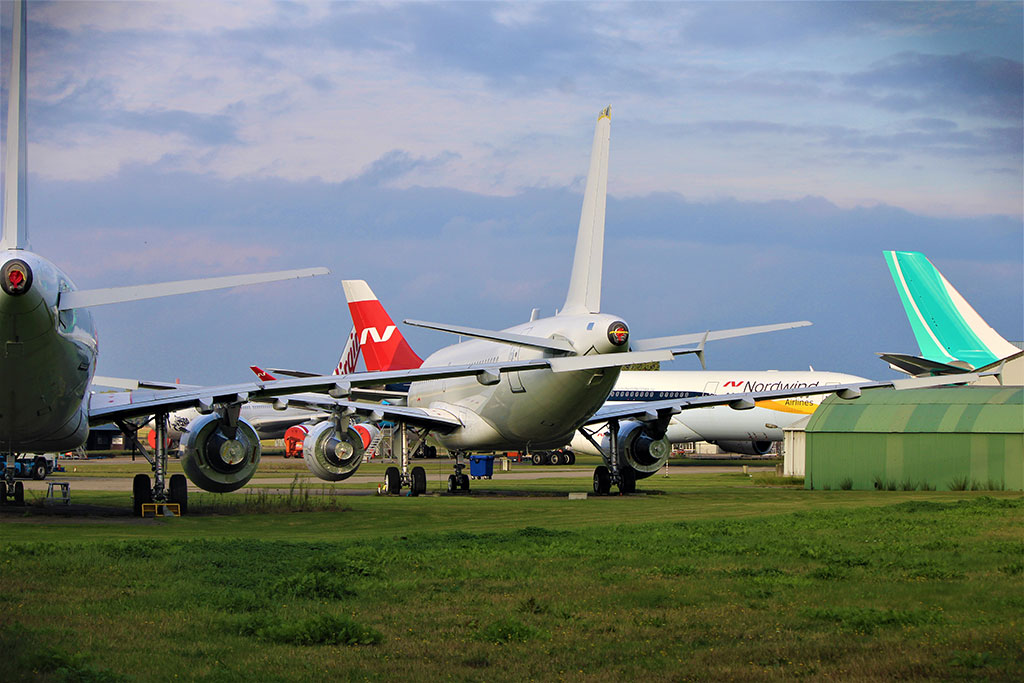
The Virgin Australia Airbus A330-200 reminded me of a very amusing experience I had 3 years ago when flying with Virgin Atlantic on this type from Gatwick to Barbados. The airline had recently leased 4 former Air Berlin A330-200 aircraft to cover their Boeing 787-9 fleet whilst aircraft went out of service for mandatory RR Trent 100 inspections. The A330-200 I flew on had been pressed into service only days before my flight and it very much felt like an Air Berlin aircraft, so much so that the inflight entertainment system was still locked to Central European time and incorrectly displayed departure and arrival times. The cabin crew found this as frustrating and confusing as the complaining passengers and when I offered my explanation for the error, I was politely but firmly told that the aircraft had not been in desert storage, was not on lease and I should not spread such rumours. To be fair to Virgin, the problem had been rectified for our return journey two weeks later and we duly arrived at the same time as the pilot said we would.
Woensdrecht turned out to be a real spotters treat, with a number of aircraft from airlines that I had not spotted before including Airbus A330-200s from Nordwind Airlines, Hong Kong Airlines, Virgin Australia and Flynas. It is certainly a while since I abandoned any car and walked several miles along foot paths to find suitable spotting vantage points. Watch out for the Dutch cyclists though, they have a habit of appearing out of nowhere when least expected but are courteous enough to ring their bell. Back into the car and off to my final spotting destination of the day, the Friendship B&B.
Hoogerheide – A night stop at a rather special B&B
You wouldn’t expect me to put a residential address into my Sat-Nav when moving on to my next spotting location, but that is exactly what I did. If one thing opitimises the meaning of “family” when I refer to “Meet the Fokkers” then it is the Friendship B&B in Hoogerheide, my next destination and only a couple of miles from Woensdrecht. Being so close to Woensdrecht, the small town of Hoogerheide has developed a strong and long-lasting affiliation with Fokker and its aircraft, and none more so than Esther and Gerhard Horstink who own the Friendship B&B.
As if finding a Fokker airliner on the roof of an airport or above the offices of a scrap metal company wasn’t enough for one day’s spotting, I can assure you that the Friendship B&B kept the best surprise till last. Located in the garden, and not looking one bit out of place is F27-400M PH-FCX. Not only is the aircraft complete and in excellent condition, but it is fitted out rather impressively as a bedroom suite complete with its own sauna.

F27 PH-FCX Friendship B&B
I had to ask the obvious question, how did the F27 end up at this charming B&B? Both owners caught the Fokker “bug” whilst growing up in the local area and have developed their affection for aviation throughout their adult lives. Esther bought an introductory flying lesson as a 40th birthday gift for Gerhard, who loved flying so much he went on to hold a PPL. Not so passionate about flying but keen to keep the Fokker spirit alive in Hoogerhilde, Esther decided to look for a Fokker Friendship with the intention of converting it into a bedroom as part of their B&B establishment.
Where do you look for a used Fokker Friendship? The Internet of course! This is exactly what Esther did and she came across PH-FCX for sale at PS Aero located 150km away in the South Eastern region of the country. This aircraft had been delivered new to Turkish Airlines in 1961 as TC-TEK and after 12 years service returned to Fokker who converted it into an F27 Maritime demonstrator. In this role the aircraft was a frequent visitor to the UK with Fokker using it on the air show circuit with Farnborough 1976 being her first public demonstration.
No one believed that the Horstinks could pull off this audacious idea, but they did and have succeeded in creating an exquisite hotel suite. The attached video not only captures the aircraft’s journey from PS Aero to becoming a fine garden exhibit, but also the transformation from airliner to hotel bedroom. Attention to detail in creating such a superb living space is clearly evident in the website video, look out for the installation of the NASA grade insulation technology that provides such perfect temperature control inside the suite/airliner. Unfortunately, the suite was booked on the night of my stay so I will have to return another day with Mrs. M and sample this jewel of a night stop! For those of you who enjoy fine wine, The Horstinks also have an established wine importing business and host regular wine tasting events at the B&B during the Autumn/Winter period.
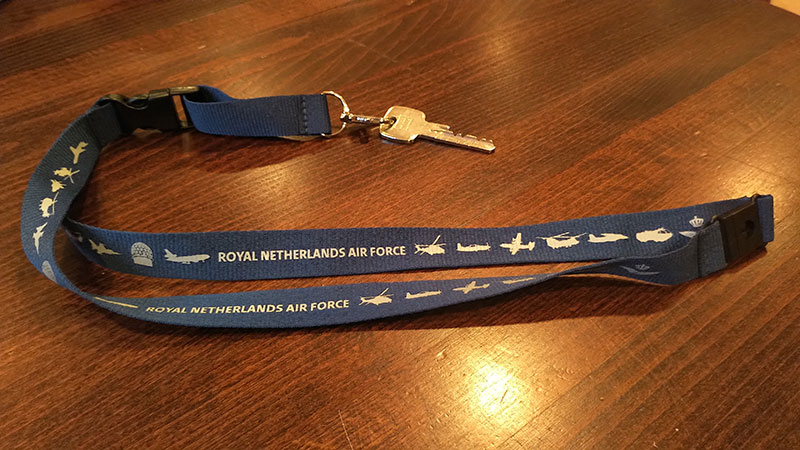
B&B room key on RNAF lanyard
Friday 15th October: Eindhoven Airport: The gift that never ceased giving.
The reason for including Eindhoven on my “Meet the Fokkers” trip was to spot former Royal Netherlands Air Force (RNAF) Fokker F27-300M registered C8. Delivered originally for transport duties, the RNAF later fitted the nose section from a Lockheed F104G to C8 and used the aircraft for fighter jet pilot training. Located as a gate guardian at the entrance to the military section of the airport, the aircraft stands well on a small piece of grass land and can be photographed with ease. Whilst the location is in front of the main entrance to the military base, I found a private car park just across the road from the aircraft which I used un hindered during my brief photographic visit.
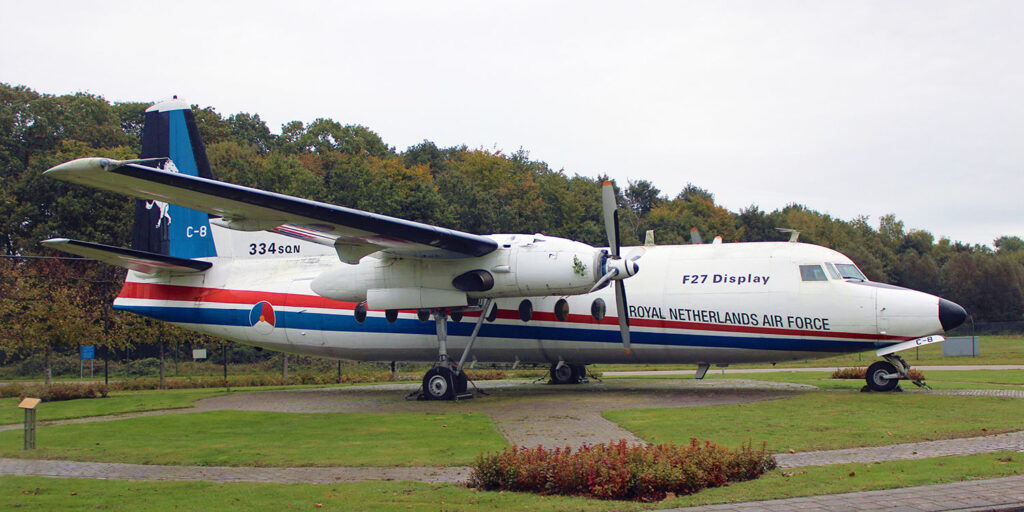
For months before this trip, I had followed the impending departure of the two Eindhoven based RNAF KDC-10 aircraft to US company Omega Aerial Refueling Services and was hoping that T-235, the last example in service might still be on station during my tour. My dreams were shattered just before this trip when I learned that the aircraft had completed an official farewell tour of the Netherlands on October 7th and duly departed for California on October 9th. Just under a week before my planned visit to the airport, spotting a DC10 as part of my Challenge now looked as if it would have to wait for a future visit to the USA.
Not so! A quick check in with Flightradar24 during breakfast that morning revealed that T-235 had left California and was expected in to Eindhoven in a few hours’ time. I could not believe my luck, neither could Esther or Gerhard who had both followed the departure of T-235 the week before. For what ever reason, the former Martinair DC-10-30CF was due back in Eindhoven and yours truly would be a very happy spotter indeed. I would be even happier if the foul weather improved and the associated ground mist would lift.
The airport’s “Spottersplek” is the go-to place when visiting this airport. Open 24 hours and spanning almost the entire northern perimeter, this is a purpose-built spotting area complete with car park and good views of both the LCC and military aprons. Upon my arrival I had to stay in the car as the rain was horrendous and visibility across the airfield very poor, but I could just make out the KDC-10 parked between several RNAF Airbus A330-243 MRTT aircraft. I waited for the rain to abate and secured a photograph of T-235, the unexpected visitor.
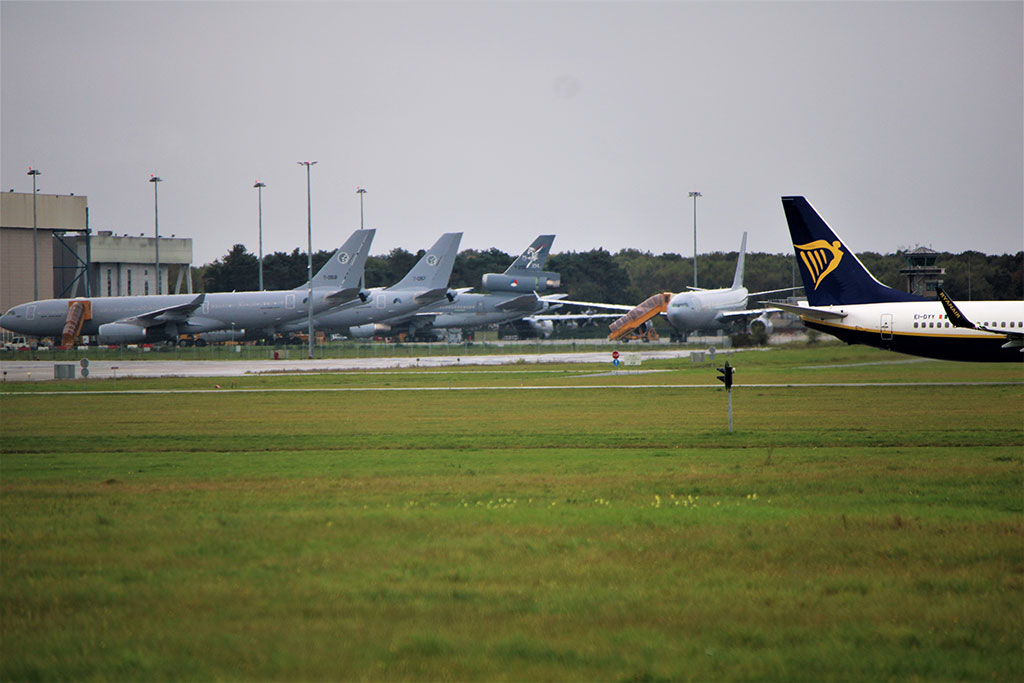
RNAF KDC 10 on crowded ramp
Seeing such a rare aircraft reminded me of my first flight on a Douglas DC-10, a VIASA example from Heathrow to Caracas in 1992. I had no plans to fly to Venezuela, but the opportunity to fly on a DC-10 arose when my chosen summer holiday destination was cancelled due to aircraft technical problems with another airline. I had desperately wanted to fly on an IL-62 for many years and I convinced my then partner that we should go to Cuba for our annual holiday and fortuitously the package included a return flight from Stansted to Havana on a Cubana IL-62. We travelled to Stansted only to find that our IL-62 had not left Cuba due to technical issues and that no alternative arrival date/time had been provided. The travel agent at the airport advised us that the once weekly schedule would likely be cancelled and offered us an alternative package to Venezuela departing the following day.
The spottersplek is perpendicular to the single runway and affords great views of both arriving and departing aircraft. The airport really was a hive of activity with a dozen or so Wizz Air and Ryanair movements during my brief 60-minute stop over. The KDC-10 did not move during my stay (it has since flown to Victorville, CA) but a pair of RNAF Lockheed F-16s departed and thundered directly over the spottersplek. The weather may have changed for the good, but there was a plentiful supply of water left on the runway, as illustrated by the arriving Ryanair Boeing 737-800 in the below photograph. I could never have imagined how photogenic a Ryanair aircraft could appear until now!
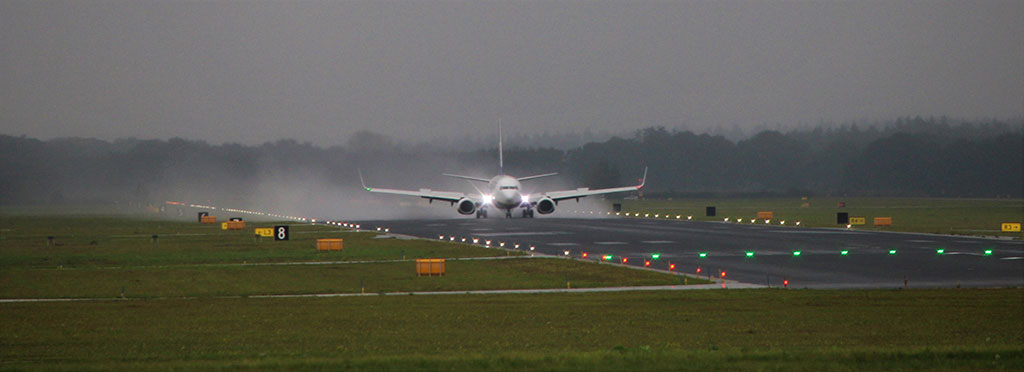
I would liked to have stayed longer, but there were still two F27s to spot that afternoon and time was precious. Firstly, onto Baarlo to spot an F27 that only arrived back in the Netherlands 4 years ago.
Baarlo: Napoleansbaan Zuid 27, 5991 NB Baarlo
This place really is the “Davis Monthan” of the Netherlands. Located in a small village close to the German border is PS Aero, the very same company that sold PH-FCX to Esther in Hoogerhilde. PS Aero is a specialist in the sale, acquisition and rental of former military aircraft, engines and spares. With over 35 historic military aircraft representing all facets of the NATO and Russian air forces, this is a must visit location if you are a military aircraft spotter.
PS Aero is a thriving business and the multiple company buildings surrounding the site make it impossible to see any of the aircraft from the main road except for the former German Air Force Typhoon and Starfighter displayed in the car park at the front of the complex. Don’t despair, PS Aero provide a 2-hour guided tour of the facility on a regular basis, so check out their website www.psaero.com and make sure you secure a place. I am not going to spoil your tour, but having passed through the car park in to the aircraft holding area it really does feel like you have walked through an “aviation portal” straight into a far-flung corner of Arizona. There was even a glimpse of the sun to add to the illusion.
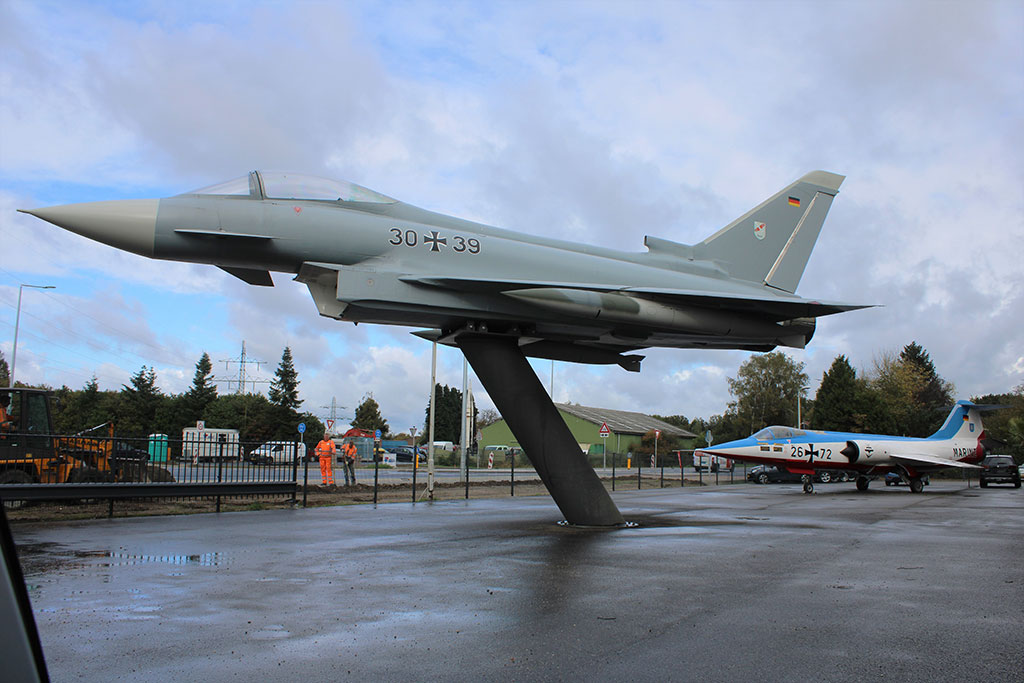
In addition to owning such an eclectic array of military aircraft, PS Aero also have several very special civil airliner residents. Alongside Fokker F27-500 AP-BHZ, PS Aero also own F-BHRA, the first production SE.210 Caravelle 3, an aircraft I spotted on a number of occasions during my frequent trips to Ringway airport in the late 1960s and early 1970s. I must confess that when I started this Challenge I never envisaged spotting a Caravelle in such a non obvious location as this. The “Tempelhof” air stairs seen in the Caravelle photograph are authentic and form part of the many aviation artefacts that PS Aero rent out to the film industry. These air stairs along with many other 1960 era aviation props were leased to Stephen Spielberg in 2015 during the making of the film “Bridge of Spies” in Berlin. Maintaining the “French” airliner connection, PS Aero also have on display the forward fuselage from the first production Dassault Mercure 100 F-BTTJ.
PS Aero is run by Piet Smedts who is not only a great host but possibly the most knowledgeable aviation individual I have ever met. The list of resident aircraft is constantly changing; PS Aero recently sold a former Swiss Air Force Dassault Mirage IIIRS to the Pima Air and Space Museum and one of their Jaguar GR3 exhibits is scheduled to depart soon to a private buyer. F27 AP-BHZ was delivered new to Air Wisconsin in 1985, returned to Europe in the 1990s, later acquired by ASSL in Pakistan before returning to the Netherlands. The aircraft was still flying only 5 years ago and looks in superb condition.
On to my next spotting destination, just 30 minutes drive away and across the border into Germany.
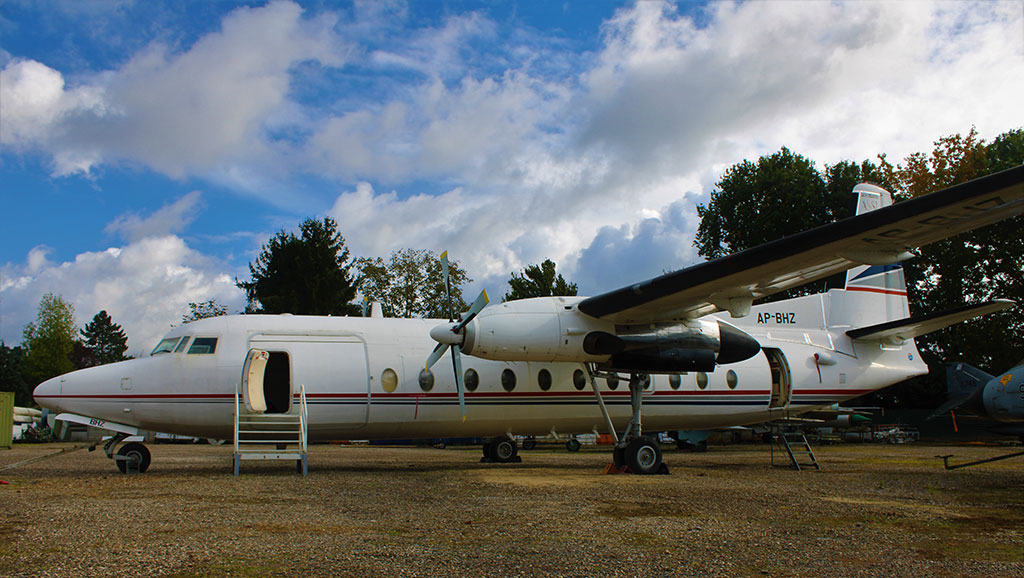
F27 AP-BHZ
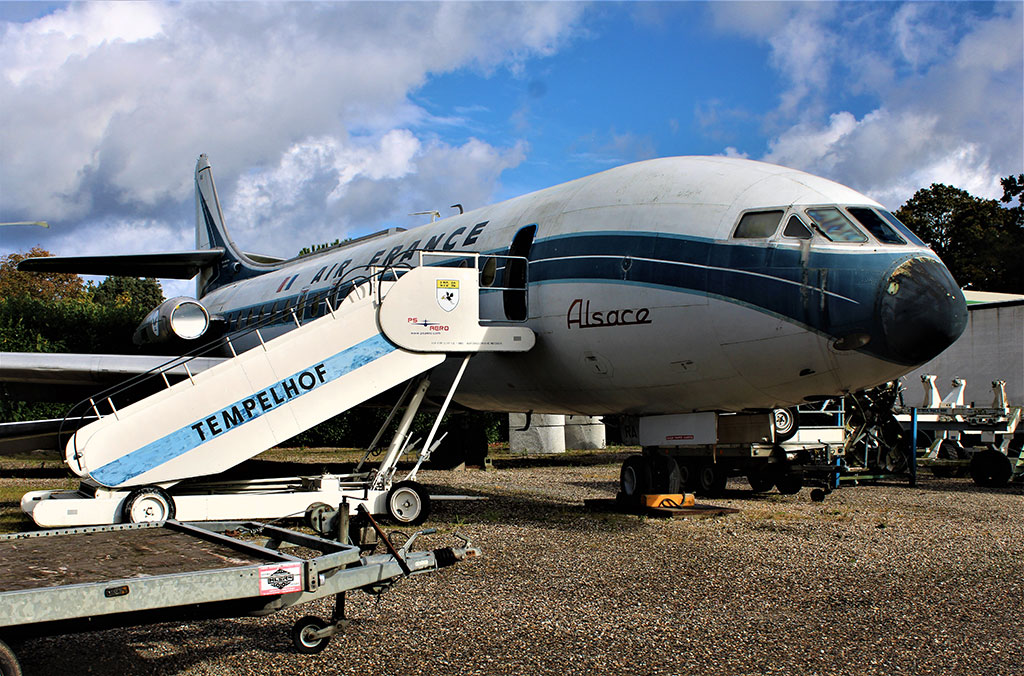
SE210 Caravelle F-BHRA
Irrland International Airport: AM Scheidweg 1 47624 Kevelaer
You will not find this airport listed in Flightradar24, but it does exist, complete with airport terminal, runway and a handful of aircraft that should be on any spotters list. Irrland children’s theme park is what it says on the tin, but in addition to the many children’s rides and animal enclosures, the theme park has its very own airport. In addition to several fake CRJ’esque Lufthansa and Air Berlin aircraft parked in front of the terminal building, the “airport” also hosts a former Italian Air Force Aeritalia G222, Antonov An-2, former German Air Force Transall C-160 and NLR Fairchild Metroliner II. The prize today with regards to my spotting Challenge is Aeritalia G222 MM582, poised at the easterly end of the runway about to touch down on the grass runway. A true enigma if ever there was one.
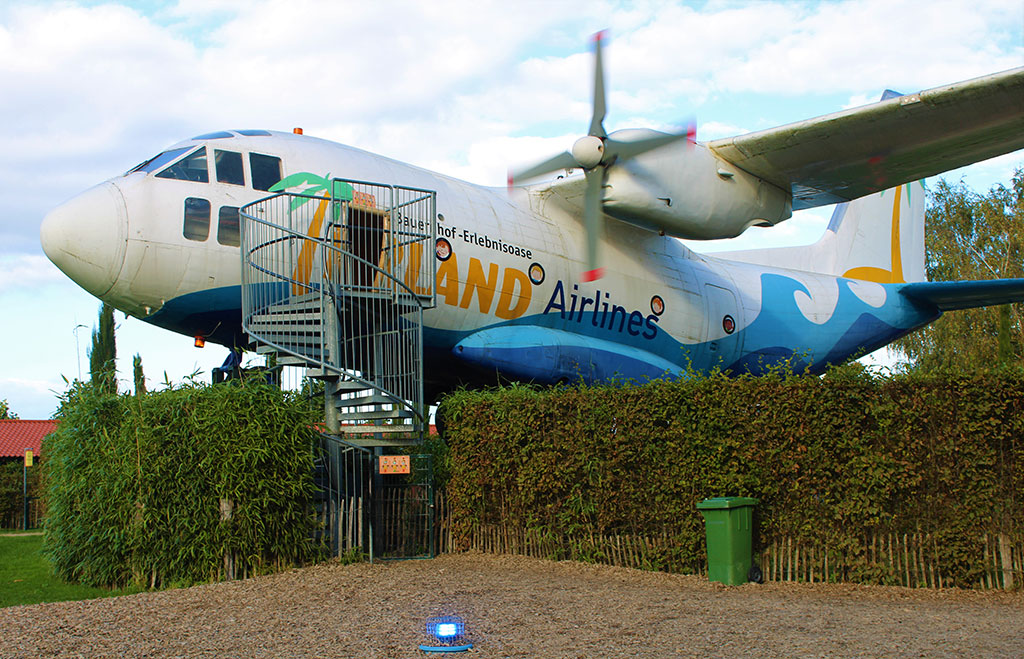
Aeritalia G222 MM582
The aircraft are well presented albeit sometimes in strange liveries as demonstrated by the Aerilatia G222. I doubt there are many places in the world where one can just rock up and board an Aeriltalia G222 and sit on the flightdeck? Should you visit this intriguing site for spotting purposes, please be mindful that this is a children’s park especially when using a camera in front of the aircraft attractions.
I am informed that the owner of Irrland theme park is a keen aviation buff, hence the airport and aircraft exhibits. No prizes for guessing who supplied this interesting collection of aircraft, our good friend Piet Smedts of PS Aero. May Baarlo and PS Aero remain the epicentre for supplying historic aircraft for preservation purposes, what ever their intended use!
Cologne Butzwelerhof Airport: Butzheillehofalle, Butzweilerstrasse 35-39 Cologne
I was drawn to this former airport not just to spot Fokker F27-600 D-AELM, but to witness first hand the surviving 1930s era passenger terminal. The buildings are now thankfully listed and provide a rare glimpse of inter-war German airport architecture. Much of the airport terminal apron has been converted into a small park which forms the centrepiece for the many modern apartment buildings that have been built around the site of the former airport. Thankfully, sufficient space has been left to accommodate the F27 directly in front of the main terminal lobby and this helps maintain the magic of this magnificent aviation spectacle. If you like cars then I would suggest that you visit the Motorworld complex also located on the former airfield site. There are many German classics to be seen and it is well worth the time.
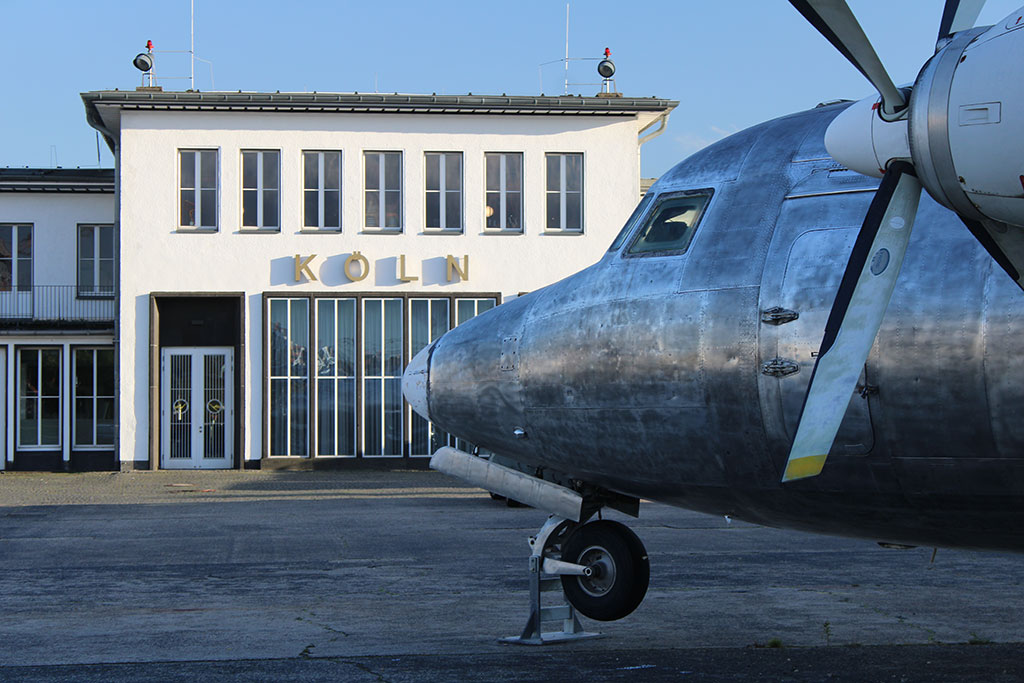
F27 D-AELM parked in front of terminal lobby
You will note that the F27 has been stripped down to its original metal finish, offering no trace of her former identity. The aircraft was delivered new to the Ivory Coast Air Force in 1970 and ended her flying career as D-AELM with WDL before being purchased by Motorworld in 2020. I do hope the recent purchase and paint stripping is a good omen and a sign that this fine example of a F27-600 will be around for many years to come and will perhaps be joined by additional aviation related exhibits?
I hung around the old Cologne airport and Motorworld exhibition to allow for the Friday night traffic to ease off before heading to my new B&B on the outskirts of Maastricht.
Saturday 16th October: Maastrict Aachen Airport
Located in the southern most part of the Netherlands, the airport is shoe-horned between Germany and Belgium and clearly benefits from the cargo business generated from the strong manufacturing base in the surrounding regions. With less than a dozen flight movements per day (and those mostly cargo related), I wasn’t quite sure what to expect from Maastricht but I knew that former Air Hollandia Fokker F100 PH-ABW would be present if nothing else. I was woken up just after 6:30am by not one but two Qatar Boeing 777F aircraft on finals inbound from Panama City; the two aircraft had tracked each other only minutes apart during the entire journey from Latin America.
The early morning mist had thankfully lifted when I arrived at the airport, and I was pleasantly surprised by the array of “in between owners” regional airliners scattered across various taxiways and ramps. The Air Hollandia liveried Fokker 100 was parked on the western side of the airport and was in close proximity to several CRJ aircraft in various stages of being parting out. This aircraft was delivered new to Air Inter in 1995 and served with the airline until 2011.
Of personal interest and also parked close to the Fokker 100 was the former Air Exel Embraer Brasilia, a type that I occasionally took between Paris and Rotterdam until the finance director of the company I worked for at the time questioned why I couldn’t take the perfectly adequate rail connection between the two cities. Another spotter caught out! The eastern side of the airport looked very interesting and I headed off to rummage through what looked like 20 or so assorted regional airliners.
The majority of the aircraft had belonged to the former Flybe, with 9 Bombardier Q400s and half a dozen Embraer jets scattered around the perimeter fences. These aircraft have been resident at Maastricht airport for some time and it is certainly good news to learn that some if not all of the Q400s will eventually return service with Flybe 2.0. In addition, there were several pristine looking Astana Embraer E190s, four former Alitalia Embraer 175s now with British markings, an Adria CRJ 900 and three white tailed Bermudan registered Airbus A220 aircraft previously destined for Redwings.
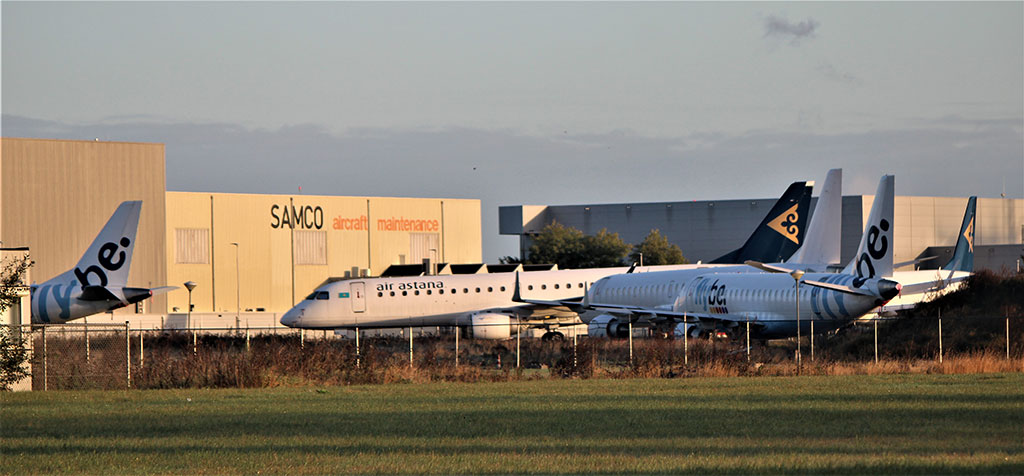
Embraer mix including two Air Astana aircraft
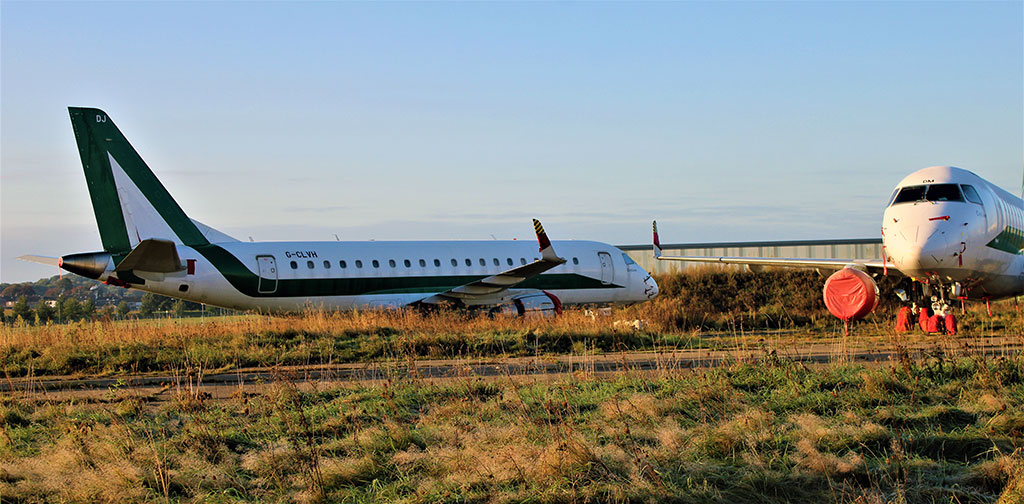
Maastricht Fokker 100 spotted, I departed for the long drive up to Schiphol and the last Fokker on my spotting list.
Schiphol: Fokker Weg, Oude Meer.
Fokker F27 100 PH-NIV (officially N19XE) is located at Oude Meer just a short drive from the airport and is perched on pylons above a small pond on land that was once part of the Fokker manufacturing facility until the company folded in 1996. For me this is the “spiritual” home of Fokker regional airliners and no better place to end this spotting trip than with an F27. This aircraft was delivered new to Air France Postal Services in 1971 and before arriving at its current location in 2011, spent a number of years in storage at Kemble. The hairs on my neck popped out when my Sat Nav announced “You have arrived at your destination” and I could see the words “Fokker Weg” displayed on the console!
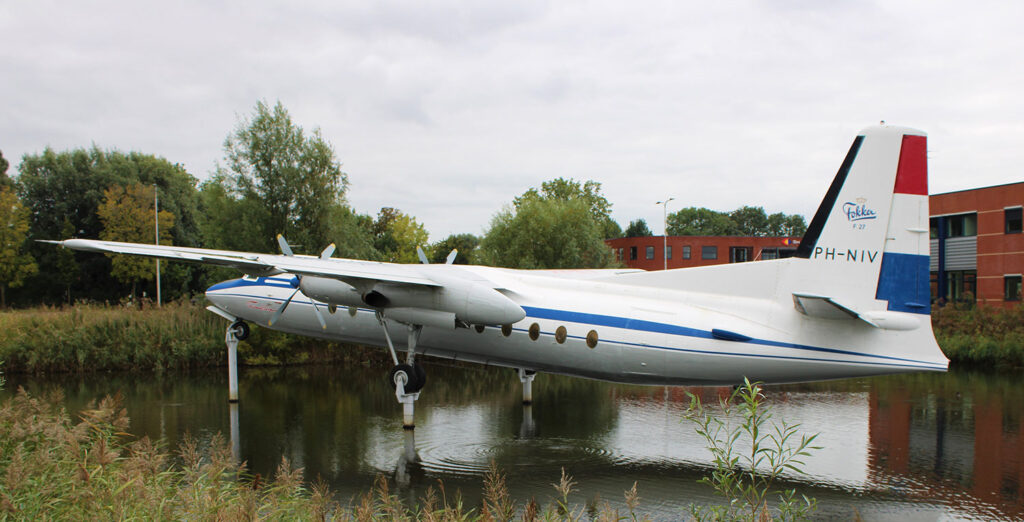
I only had the pleasure of sampling one flight on a Fokker F27 and that was back in 2001 when I took a Celtic Airways flight from Luton to Liverpool. This was the last time I flew on a RR Dart powered aircraft of any description! Finding somewhere legal to park the car for the few minutes needed to shoot PH-NIV can be a challenge but I did find a spot just 200m away. To protect the innocent who assisted me in this exercise I have chosen not to divulge the location publically. Matt can put you in touch with me should you require the location and I will happily share it with you.
Having returned to the car and feeling rather smug, without notice ULS A310-300F TC-VEL appeared over the large logistics buildings to my right and departed right above me. Having been caught in the process of buckling up and with the wrong lens fitted to the camera, this was the photographic opportunity of the trip that passed me by.
With my negotiated 5-minute “stay” about to expire, I set off for the main airport for a few hours of good old-fashioned plane spotting from an airport terminal roof terrace. The weather had perked up too and the omens looked good having started my visit to Schiphol with the ULS A310. It later transpired that this aircraft was in fact the highlight of the afternoon for me from a spotting perspective.
I spent the next 3 hours on the Panorama Roof Terrace, and although the number of aircraft movements remains well below pre-COVID levels I thoroughly enjoyed spotting aircraft types and airlines I hadn’t seen for several years. It was a delight to see several Boeing 767s parked together, and it is a while since I spotted six in-service Boeing 747s parked in a line. I took many photographs during the afternoon’s brief spotting stint but I have selected to share the one of 737 MAX 8 TF-ICU for a particular reason. Following prolonged grounding, I purposely tried not to spot this aircraft type in flight so that I could catch one close up at an airport. The Panorama Terrace allowed me to get really up close to a number of 737 MAX aircraft and I am pleased I made the decision to hold off spotting the type until I travelled to the Netherlands.
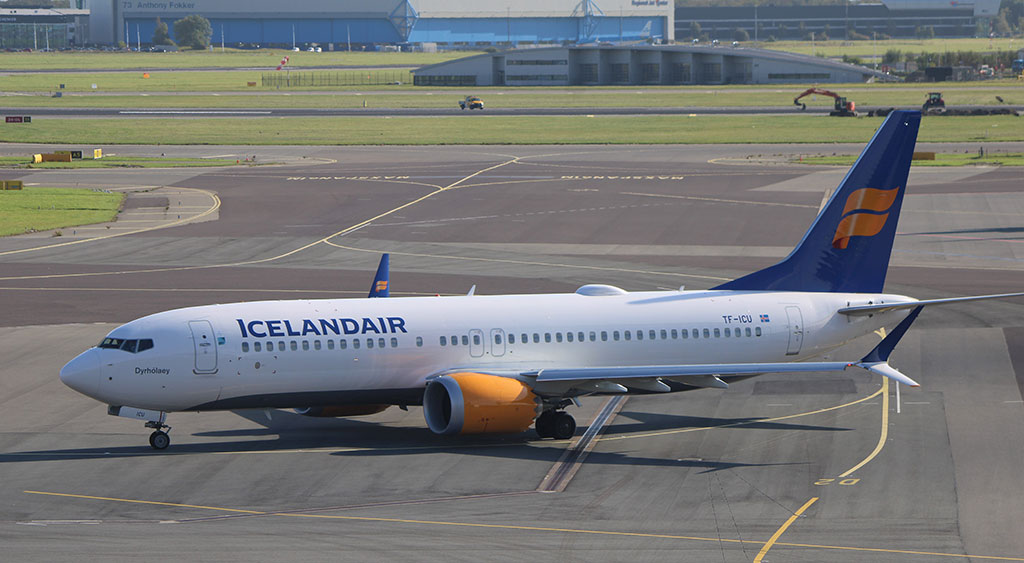
Icelandair 737 MAX 8 TF-ICU
It is amazing what Boeing has done to this aircraft; it is very much different from the first Boeing 737 I spotted during a trip to Heathrow in 1969 (a Lufthansa series 100). What was most noticeable to me with the MAX 8 over all previous Boeing 737 variants is the “stance” of the aircraft. The 9-inch nose wheel extension to accommodate the wider engine nacelles is most visible in the photograph below and gives the aircraft a “grown up” appearance compared to previous variants.
If I required confirmation that things were slow at Schiphol, the many departure area shops and restaurants that were closed posed a stark reminder that we have a long way to go before returning to normal. Things must be slow, even Murphy’s Bar was closed on a Saturday evening. No Dreamliner for the homeward flight either, but I was promptly whisked home on a British Airways A319.
So how was the family reunion?
I have always been particularly fond of the Fokker family of regional airliners and it was delightful to be re-acquainted with so many again, it really did feel like I was meeting up with some long-lost relatives. The aircraft spotted in this report still exude that rugged and robust nature that the airlines who operated them speak so highly about. Great to fly, simple to operate and easy to fix when needed and get back up in the air quickly.
List of Fokkers spotted during this trip:
| F27 | Fokker 50 | Fokker 70 | Fokker 100 | |
| Schiphol | PH-NIV | PH-OFE | ||
| Lelystad | PH-FHF
PH-NVF |
PH-OSI | PH-OFA | |
| Breda | PH-EZH | |||
| Woensdrecht | 5B-DDA
5B-DDB |
5B-DDE
PH-MKH |
||
| Hoogerheid | PH-FCX | |||
| Eindhoven | C8 | |||
| Baarlo | AP-BHZ | |||
| Cologne | D-AELM | |||
| Maastricht | PH-ABW |
Looking at the above list I cannot help but think if we could turn the clock back 25 years and were gifted the above fleet, we could start up a nice little airline and do some good business with this fine mix of Fokker aircraft.
There was one F27 that went missing from my trip – the example preserved at the RNAF Museum at the former Soesterberg Air Base.
So where can you take a scheduled flight aboard a Fokker aircraft today? Closest to home in Europe is Amapola Flyg flying domestic services out of Stockholm with their mixed cargo and passenger fleet of Fokker 50s. As for a flight on a Fokker 70/ 100, your best bet is down under where you will find a healthy number of aircraft still in regular scheduled service with airlines such as Alliance.
I went to the Netherlands to “Meet the Fokkers” and most certainly did. The Dutch people, KLM, Fokker and their beloved aircraft are in fact all part of an “extended Fokker family” and this is quite extraordinary to witness. For just a couple of days I felt like an honoree member of this unique family. I am following the Netherlands Transport Museum’s efforts to bring home a Fokker F28 from Bamako airport in Mali with great interest, and when it happens, I will gladly join the long queue eager to see this Dutch masterpiece.
I have to confess that it is 17 years since I last visited the Netherlands. It most certainly will not be too long before I return to this fabulous country, with or without an F28 to spot.





6 comments
What a great trip and loved reading the nice and entertaining story (as I am also a big Fokker fan :-), much appreciated. I miss a few of the listed ones so good to have exact addresses now at hand.
thanks!
Thank you, John, for another fascinating and impressive report. I am amazed that you could squeeze so much spotting, at so many different locations, into a three day trip.
I am also full of admiration for all the research that you must have done. Clearly a labour of love – which is much appreciated.
what about this BAC 1-11 ??
https://www.jetphotos.com/photo/9781555 at Duxford UK.
Great trip John indeed. If you like Fokkers, you should come here to Australia, as we have still in service..58 F-100s based between Perth and Brisbane airports; 14 F 70s also between PER and BNE; 2 F 50s based in Adelaide with two more parked intact; 2 airworthy F.27s at Illawarra airport near Sydney; plus 2 F.27s on display and one F.28-1000 intact at a BNE engineering college.
So Australia is Fokker country.
F.27 PH-FHF did liver in NZ and here in AUS and I photographed it in 3 different colour schemes. Enjoyed your journal very much.
And yes, both Duxford and Weybridge have intact BAC 1-11s and I have been on board both.
A very interesting read, and well illustrated with some great photos.
I only flew on one Fokker aircraft – a Mesaba F 27 (N279MA) between Detroit & Dayton (Ohio) in 1990.
G222 is actually MM583